SPECIAL REPORTS AND PROJECTS
How the pandemic impacted rainforests in 2020: a year in review
Published
5 years agoon
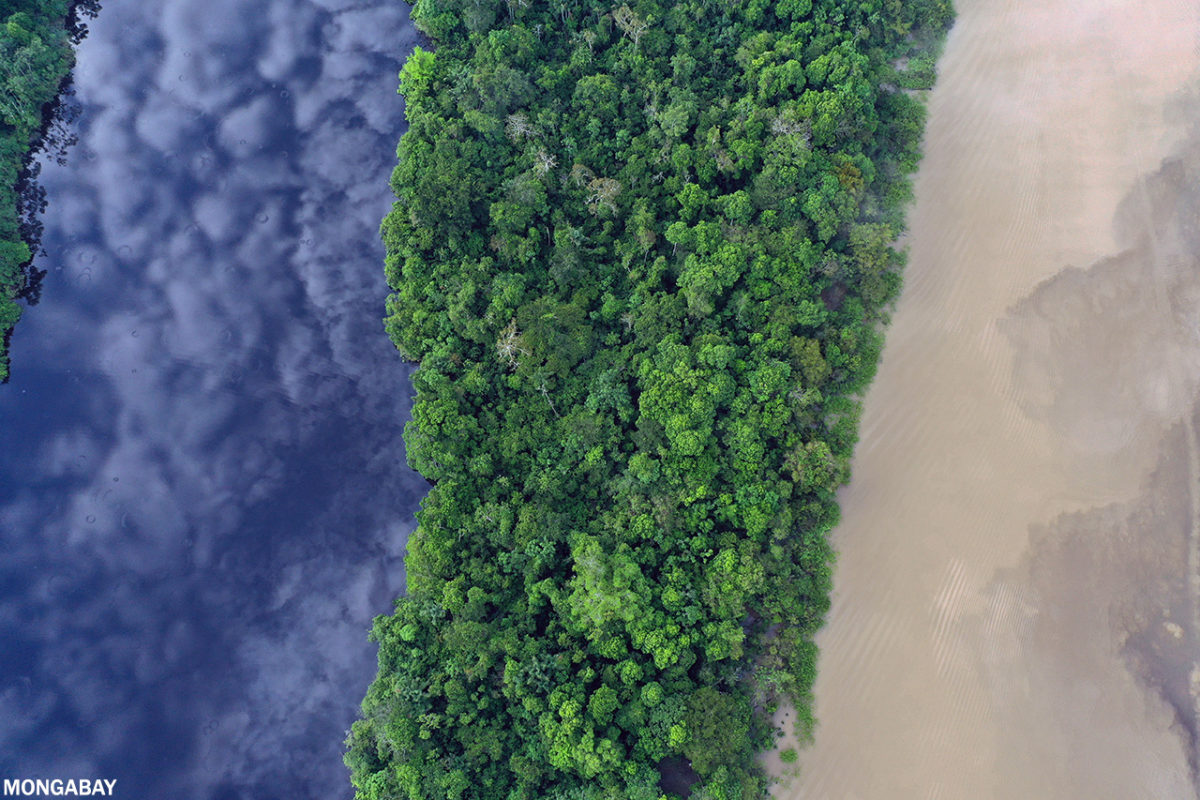
- 2020 was supposed to be a make-or-break year for tropical forests. It was the year when global leaders were scheduled to come together to assess the past decade’s progress and set the climate and biodiversity agendas for the next decade. These included emissions reductions targets, government procurement policies and corporate zero-deforestation commitments, and goals to set aside protected areas and restore degraded lands.
- COVID-19 upended everything: Nowhere — not even tropical rainforests — escaped the effects of the global pandemic. Conservation was particularly hard in tropical countries.
- 2019’s worst trends for forests mostly continued through the pandemic including widespread forest fires, rising commodity prices, increasing repression and violence against environmental defenders, and new laws and policies in Brazil and Indonesia that undermine forest conservation.
- We don’t yet have numbers on the degree to which the pandemic affected deforestation, because it generally takes several months to process that data. That being said, there are reasons to suspect that 2020’s forest loss will again be substantial.
Previous rainforest year-in-reviews:
The 2010s | 2019 | 2018 | 2017 | 2016 | 2015 | 2014 | 2013 | 2012 | 2011 | 2009
Like virtually everything in 2020, COVID-19 defined the year for tropical rainforests.
2020 was supposed to be a make-or-break year for tropical forests. It was the year when global leaders were scheduled to come together to assess the past decade’s progress and set the climate and biodiversity agendas for the next decade. These included emissions reductions targets, government procurement policies and corporate zero-deforestation commitments, and goals to set aside protected areas and restore degraded lands. These meetings were to be set against a backdrop of a “lost decade” for tropical forests, where progress on arresting deforestation fell short of ambitions, violence against environmental defenders surged, the effects of deforestation and climate change on forests became more apparent, and outright hostility toward tropical forest conservation grew in some of the world’s largest countries. Yet there were reasons for cautious optimism for tropical forest conservation coming out of the 2010s. The impacts of climate change were becoming so apparent that they were finally starting to provoke a response from the public and private sector; recognition of the role Indigenous peoples play in stewarding forests was rising; technological advances were improving forest monitoring to the extent that ignorance was no longer an excuse for inaction; and interest in forest restoration was reaching new heights.

COVID-19 upended everything: Nowhere escaped the effects of the global pandemic. As COVID spread around the world between February and April, many governments responded with lockdowns, which brought travel, commerce, and industrial production to a halt. Stock markets plunged, the skies above some of the world’s most polluted cities cleared, and carbon emissions fell at a rate unprecedented since World War II. Governments in some countries pumped money into their financial systems, buoying stock markets and kick-starting a euphoric surge in asset values. The price of many commodities that are major drivers of tropical deforestation rebounded sharply. As the lockdowns yielded to pressure to reopen economies and societies, some governments put forth bailouts, economic stimulus packages, and other incentives for forest-destroying industries. Millions of people left cities for the countryside, reversing a long-term trend of migration to urban areas.
Conservation was particularly hard hit in tropical countries. Many NGOs pulled out of field projects, conservation livelihood models dependent on ecotourism and research evaporated, and governments in countries like Brazil and Indonesia relaxed environmental regulations and law enforcement, unleashing a spasm of illegal logging, mining, land invasions, and forest clearing. Deforestation in Brazil, which was already trending upward before COVID, hit the highest level since 2008.
2019’s worst trends for forests mostly continued through the pandemic. Fires in Australia that began in mid-2019 burned into March, while drier-than-normal conditions in the Amazon enabled another active fire season. Governments used COVID as an excuse to crush dissent and critical voices, or were too distracted by the crisis to address rising violence against environmental and human rights defenders, more than 300 of whom were killed in Colombia alone. Social media platforms like Facebook continued to be weaponized against environmental journalists and campaigners.

But as the losses mounted and the world descended into darkness, there were green shoots of hope for environmentalists. Lockdowns provided a tantalizing glimpse into a world with a diminished human footprint and the potential for humanity to come together around a common threat — the kind of unified action needed to address climate change, for example. Skies and rivers cleared, traffic disappeared, and wildlife reclaimed haunts long ago ceded to cars and people. Observers looking for a silver lining hoped that the pandemic would force humanity to reevaluate its relationship with nature, potentially driving a shift toward a more sustainable, resilient, and equitable economic system. Interest in renewable energy, regenerative agriculture, and the circular economy blossomed. A protest movement emanating from repeated extrajudicial killings of Black and Indigenous peoples in the United States and abroad resonated from Milwaukee to Merauke, spurring calls for change and pushing many conservation organizations, especially in Europe and the U.S., to take a hard look at issues of equity, justice, and inclusiveness.
The U.S. presidential election in November raised hopes that the world’s biggest economic power would reassert a leadership role on global affairs, including rejoining the Paris climate agreement. The rapid development of COVID-19 vaccines raised the prospect of the world returning to “normal” far faster than was envisioned at the start of the pandemic. But no one knows what would a return to normalcy would mean for the world’s rainforests.
The big picture
According to satellite data, deforestation of tropical primary forests has been trending upward since 2000, with the average loss in the 2010s nearly 30% higher than the 2000s, despite global efforts to curb deforestation. The second half of the 2010s had the highest rate of loss during the period, registering about 50% higher than 2010-2014. The three years with the highest extent of primary tropical forest loss in the past 20 years occurred in 2016, 2017, and 2019.

We don’t yet have numbers on the degree to which the pandemic affected deforestation, because it generally takes several months to process that data. A couple of studies attempted to quantify loss in the first few months of the pandemic using unconfirmed alert data from the University of Maryland and Global Forest Watch. But because the data are unconfirmed, the analyses cannot be used to compare loss to prior years, limiting their utility. We should expect updated data to be released in the first quarter of 2021.
That being said, there are reasons to suspect that 2020’s forest loss will again be substantial, not the least of which is because deforestation in the Brazilian Amazon — which accounts for more than 60% of Earth’s largest rainforest — has been pacing ahead of last year. The pandemic has resulted in several conditions that would be expected to favor a rise in deforestation. Prices for most major commodities that drive deforestation, including palm oil, soy, and timber, have increased since the start of the year. The exceptions are beef and fossil fuels, but fossil fuel extraction itself is not a major direct driver of deforestation; instead, it tends to be the roads and infrastructure associated with energy development that drive deforestation. The sharp rise in the price of minerals and agricultural commodities will incentivize infrastructure expansion, despite the decline in energy prices. Additionally, government stimulus in tropical countries, where it exists, has been oriented toward infrastructure and supporting existing industries. Stimulus may include direct financial transfers as well as policy interventions, like reducing environmental regulations and making it easier to secure new concessions. Government priorities have also shifted to health and social programs, diverting resources from environmental law enforcement. Another impact of COVID-19 has been to reverse the long-term rural-to-urban migration. This trend, which may not be sustained long after the pandemic, would be expected to increase pressure on forests for small-scale agriculture.

In ‘the Before Times’
While the pandemic set the tone for 2020 from March onward, there were some significant developments for tropical forests during first few months of the year.
2020 opened with bushfires continuing to rage across eastern Australia after breaking out in September 2019. By the time Australia’s “Black Summer” was over in March, about 18.6 million hectares (46 million acres) of land had burned, including 80% of the Blue Mountains near Sydney and 50% of Gondwana World Heritage rainforests in New South Wales and Queensland.
At the World Economic Forum in Davos in January, U.S. President Donald Trump jumped on the tree-planting bandwagon that gained traction in 2019, announcing that the U.S. would join the “One Trillion Trees Initiative,” an effort to combat climate change by planting trees. He followed that up by mentioning tree planting during his State of the Union address in January. Critics noted, however, that the Trump administration’s policies throughout his presidency have been strongly at odds with efforts to protect and restore forests.
In February, Pope Francis released “Querida Amazonia,” an apostolic exhortation calling for the protection of the Amazon rainforest and improving the quality of life for people in the region, among other points. The document won plaudits from some environmentalists and Indigenous rights advocates, but drew the ire of Brazilian President Jair Bolsonaro.
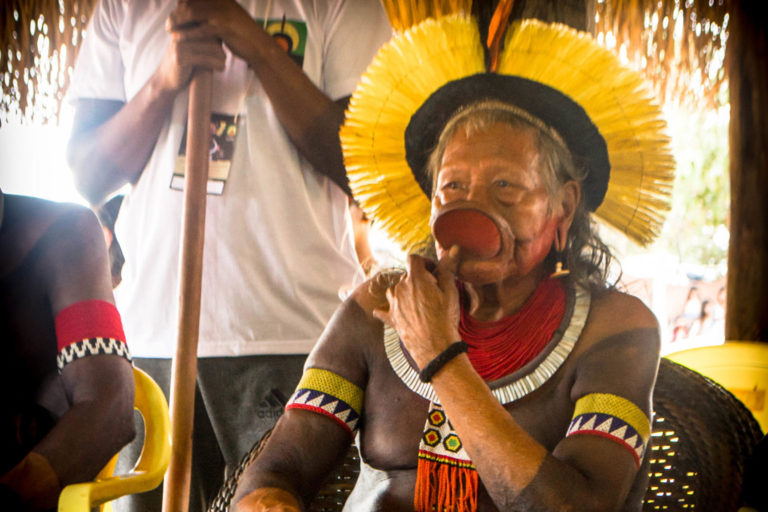
Concerns over Bolsonaro’s policies and heated rhetoric against Indigenous peoples brought together more than 600 leaders from 47 Amazonian tribes in February. The meeting, called by 89-year-old Kayapó Chief Raoni Metuktire, produced the Piaraçu Manifesto, which denounced the Brazilian government’s efforts to open the Amazon to more mining, logging, and industrial agriculture, and promote more roads, dams, and other large-scale infrastructure in the region.
The impact of coronavirus on rainforests
Coronavirus spread to the extent that by mid-March many governments around the world were issuing shelter-in-place orders, which peaked on April 7. Lockdowns triggered a global freeze on travel, collapsing conservation business models based on ecotourism or visits from researchers, and prompting international NGOs to retreat from many field sites. Law enforcement evaporated in some places, resulting in an increase in illegal activities, including logging, poaching, invasions of Indigenous lands and protected areas, and forest clearing, according to some accounts. Panic buying of gold triggered a surge in the price of the precious metal, ushering in gold rushes in tropical forests around the world, especially in the Amazon.

Some governments responded to the economic crisis resulting from the pandemic by plowing stimulus money into industries that drive deforestation and forest degradation while also relaxing enforcement of environmental laws. For example, Indonesia passed sweeping deregulation legislation that benefited palm oil, timber, and mining companies, while in some places, companies that were suspected to have engaged in illegal forest activities secured stimulus money.
The pandemic derailed the high-level meetings on climate and biodiversity. But while the meetings were canceled or postponed, civil society and some governments were undeterred, proceeding with the release of publications and reports on the need to take urgent action to address climate change and the extinction crisis.
If there was any silver lining to be found in the carnage caused by the pandemic, it was that COVID forced the public to reckon with the fact that many zoonotic diseases emerge from human-livestock-wildlife interactions, which are often exacerbated by environmental degradation, industrialized farming, and the wildlife trade. A report from the Intergovernmental Science-Policy Platform on Biodiversity and Ecosystem Services (IPBES) evaluated humanity’s role in creating conditions that enable pandemics and warned that COVID-19 may just be a preview of what’s to come if our behavior doesn’t change. Some scientists cautioned that the next pandemic could emerge from the Amazon due to the extent of ecosystem disturbance and the scale of livestock production in the region. Conservationists urged governments to put conservation at the center of COVID-19 recovery efforts.
Open season on environmental defenders
COVID-19 enabled and emboldened crackdowns on environmental defenders, which were already worsening going into 2020. In July, Global Witness announced that 2019 was the deadliest year ever for environmental activists, with 212 deaths recorded. 2020 appears to have far surpassed that record, with 300 killings of environmentalist and human rights advocates reported in Colombia alone through mid-December. High-profile murders ranged from monarch butterfly defender Homero Gómez González in Mexico in February to a massacre of 12 wildlife rangers in DRC’s Virunga National Park in April.
Read more: Notable deaths in conservation in 2020
A difficult year for Indigenous communities in the Amazon and beyond
Beyond the apparent uptick in violence, Indigenous communities around the world struggled to deal with the impact of COVID-19. Early in the pandemic, there were cases of Indigenous peoples in the Amazon being stranded in cities like Iquitos and Manaus due to lockdowns. Deprived of the ability to return to their villages and without access to quality health care, many died alone, far from home. With the death of Indigenous elders from COVID, communities lamented the irreplaceable loss of traditional knowledge. Some Indigenous groups closed off access to their lands in an effort to protect themselves from infection. Isolated communities are particularly vulnerable to diseases like COVID-19.
On the other end of the spectrum, evangelical missionaries from Ethnos360, formerly known as the New Tribes Mission, and Frontier International responded to the pandemic by allegedly attempting to establish contact with isolated Indigenous groups in the Javari Indigenous Reserve in March. Such activity is prohibited by Brazil’s constitution. The Bolsonaro administration attempted to appoint Ethnos360 missionary Ricardo Lopes Dias to lead the department of isolated and recently contacted Indigenous tribes under Brazil’s federal Indigenous affairs agency, Funai.
Lack of law enforcement in Brazil reportedly emboldened speculators to invade Indigenous lands, including territories demarcated for the Karipuna, Guajajara, Aptereua, Ituna Itatá, and Apyterewa tribes, among others. A report from the Socioenvironmental Institute (ISA), a Brazilian NGO, said the Brazilian government was failing to protect the Yanomami from invasions by illegal gold miners.
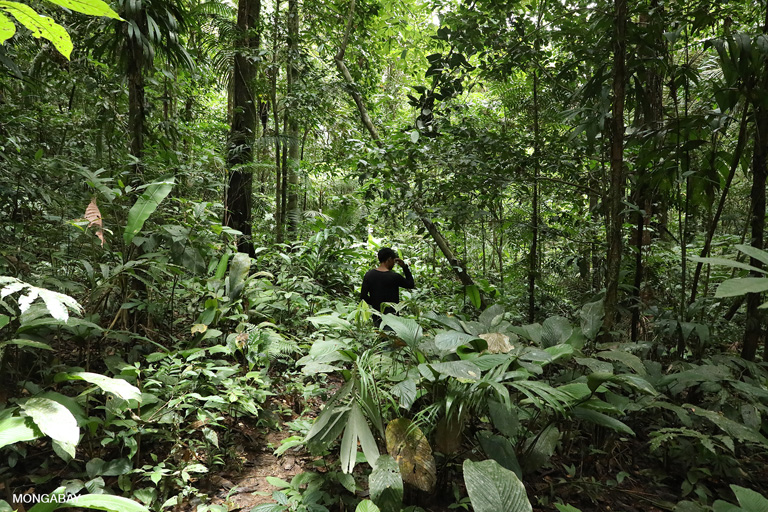
Indigenous communities continued to report troubles getting their land officially demarcated. In April, Brazil’s Funai opened 98,000 square kilometers (38,000 square miles) of as-yet-unrecognized Indigenous areas to outsider land claims made within Indigenous territories that are still going through the demarcation process. Funai’s move was immediately countered in court, but an investigation by the news outlet Agência Pública found that 114 properties spanning more than 250,000 hectares (618,000 acres) have been certified inside Indigenous territories awaiting demarcation in the Brazilian Amazon. Some of the properties were authorized before Funai had finished its required review process. For example, the Indigenous Munduruku communities in Pará complained of forest clearing for industrial soy on their traditional land.
It wasn’t all setbacks for Indigenous peoples in Brazil in 2020. In March, a federal judge ordered government websites to publish a letter from the Kinja Indigenous people for 30 days as part of their right of response to a series of racist and incendiary remarks from the Bolsonaro administration. In April, a group of Ashaninka received an official apology and about $3 million for logging of their lands in the 1980s by the family of the current governor of Acre state. The settlement came after a 14-year legal battle that reached the federal Supreme Court in 2011. In July, a federal judge ordered the Brazilian government to remove 20,000 gold miners who had illegal invaded the Yanomami reserve.

Rieli Franciscato, a field expert with Funai, was killed in September on the edge of the Uru-Eu-Wau-Wau Indigenous Territory in Rondônia state. Franciscato, 56, worked to protect the rights and territory of Indigenous peoples living in voluntary isolation in the Amazon rainforest. He was thought to have been killed by a band of “uncontacted” Wau-Wau who, due to previous violent encounters with outsiders invading their lands, wouldn’t have known that he was working on their behalf.
Indigenous peoples’ advocates warned that the Piripkura Indigenous Territory may not survive beyond 2021 as the tribe’s population dwindles. Indigenous peoples themselves said COVID-19 represented an existential threat to some communities.
The Arns Commission, a human rights body, sent a petition to the International Criminal Court demanding an investigation into the Bolsonaro administration’s attacks on Indigenous rights, arguing that its policies could constitute “genocide” if they wipe out isolated tribes.
Indigenous peoples and conservation
Recognition of the role Indigenous peoples and local peoples play in stewarding forests has been growing in conservation circles over the past decade, leading NGOs, U.N. bodies, and other actors to become stronger advocates for Indigenous rights.
In 2020, several studies further bolstered the idea that empowering Indigenous peoples is an effective approach to combating climate change and achieving biodiversity conservation goals. A paper published in Frontiers in Ecology and the Environment in January found that Indigenous lands hold 36% or more of remaining intact forest landscapes; while a Proceedings of the National Academy of Sciences study published the same month concluded that 90% of the Amazon rainforest’s carbon emissions between 2003 and 2016 came from outside Indigenous territories and protected areas. Another PNAS study, published in August, demonstrated the importance of secure land tenure, finding that forest cover was more effectively maintained in Indigenous territories that were officially demarcated. A study by the Center for International Forestry Research (CIFOR) found a similar result when evaluating community forest enterprises in Mexico, Guatemala, Nepal and Namibia.

In November, the Rights and Resources Initiative published a paper arguing that it won’t be possible to stave off the collapse of biodiversity without respecting the tenure and human rights of Indigenous peoples, local communities, and Afro-descendants.
Time magazine named Waorani leader Nemonte Nenquimo one of its 100 most influential people of 2020 for her efforts to defend her people’s territory in the Ecuadoran Amazon.
Community forest enterprises in Mexico were hard hit by the pandemic.
Recognizing social and racial injustice
Protests over police brutality in the U.S. spread well beyond its borders, forcing a reckoning on systemic racism, social injustice, and colonial legacy in a wide range of sectors, including conservation organizations, environmental NGOs and academic institutions. The #BlackLivesMatter movement in the U.S. resonated with communities from the Amazon to Indonesian Papua, sparking solidarity movements and actions.
In November, WWF released the results of a review conducted by an independent panel into long-running allegations that the conservation giant failed to address human rights abuses by rangers in Central Africa and South Asia. The report revealed that WWF knew of the allegations but “decided not to publish commissioned reports, to downplay information received, or to overstate the effectiveness of its proposed responses.”
Destabilization of the Amazon
The pandemic did not provide a reprieve for Earth’s largest rainforest, where deforestation continued its upward trend through 2020. In November, the Brazilian government announced that deforestation for the 2019/2020 year topped 11,000 square kilometers (4,200 square miles), reaching a 12-year high. There were indications that deforestation was also rising in Peru, Venezuela, and Bolivia.
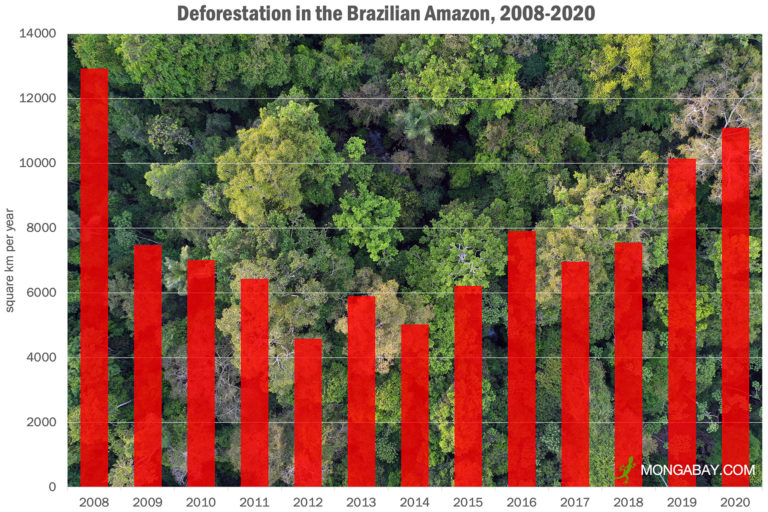
There were plenty of signs that the increase in deforestation in Brazil was not an aberration or a trend that was likely to reverse in the near term. The Bolsonaro administration pushed new infrastructure projects that could lock in pressure on forests for decades, like the Ferrovia Paraense (FEPASA) railway, Amazon river ports to facilitate increased trade with China, the reconstruction of the BR-319 highway, which would open up the largest block of the Brazilian Amazon to deforestation; the Trans-Purus road, which would cut through heavily forested areas including the Apurinã do Igarapé São João Indigenous Territory; and extending the BR-13 highway 1,000 kilometers (600 miles) to Suriname through the Trombetas State Forest. The Bolsonaro administration also took steps to open large areas to extractive industries, including oil and gas extraction and mining. A study by the World Resources Institute (WRI) and the Amazon Geo-Referenced Socio-Environmental Information Network (RAISG) found that more than a fifth of Indigenous territory in the Amazon is already affected by mining. Mining companies, including Vale, continue to bid to mine on more Indigenous lands.
With cabinet ministers suggesting the administration use the pandemic as a way to distract public attention from sweeping deregulation efforts, Bolsonaro dismantled environmental regulations, relaxed enforcement of environmental laws, moved to hand over deforestation and fire monitoring from civilian agencies to the military, and continued to replace civil servants and scientists in government positions with cronies, who in some cases had a history of working against the agencies they would be managing. Bolsonaro also continued to use heated rhetoric against critics of his environmental policy, even appearing to threaten the use of force against the United States if the incoming administration of president-elect Joe Biden tried to impose sanctions for ongoing deforestation. Bolsonaro proved hesitant to address violence against environmental defenders that followed in the wake of his heated rhetoric against activists, contributing to a sense of impunity among land invaders and illegal loggers.
Bolsonaro’s efforts often faced headwinds from independent public prosecutors, state-level governments, and the courts. For example, several lawsuits were filed to reverse the administration’s actions to ease exports of illegally logged timber and restart the suspended Amazon Fund, while a judge blocked the appointment of a controversial missionary to head Funai’s department for isolated and recently contacted Indigenous tribes. Public outcry generated from press reporting on controversial decisions was also at times an obstacle for the administration. Officials from prior administrations also put up resistance: 17 former Brazilian finance ministers and central bank presidents in July signed a letter criticizing Bolsonaro’s policies in the Amazon.
After worldwide condemnation of the Bolsonaro administration’s handling of fires in 2019, which tarnished the reputation of Brazilian business and produced threats of international sanctions against Brazilian exports, there was hope among environmentalists this year’s fire season would be better managed. But that didn’t prove to be the case, with hundreds of fires burning through forests, including protected areas, Indigenous territories, and areas set aside for “uncontacted” tribes. Progressively drier conditions across vast swaths of the Amazon means that the use of small-scale fires for slash-and-burn agriculture now risks igniting forest fires.
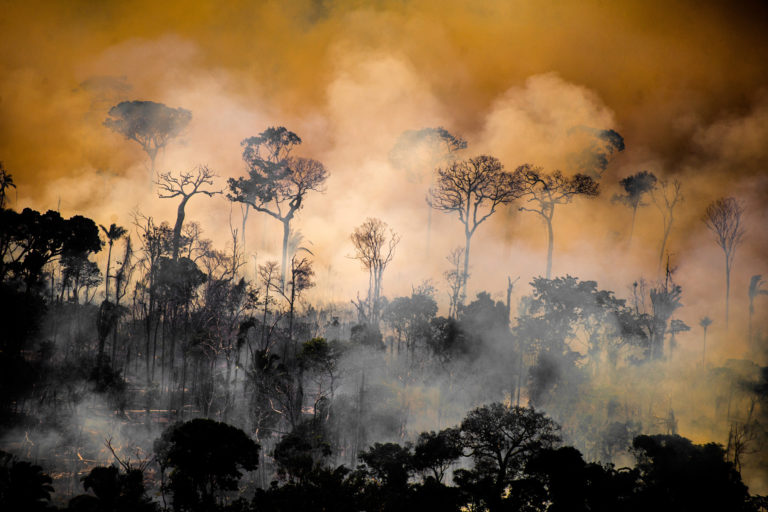
Again under pressure from the international community, investors, and some Brazilian companies for failing to curtail the burning, Bolsonaro decreed a 120-day Amazon fire ban early in the dry season and called in the military to help combat the burning. While the fire ban criminalized burning, by the end of November, 2,250 major fires had been detected by the Amazon Conservation Association’s MAAP Initiative. Forty percent of these were classified as forest fires, burning more than 2 million hectares (5 million acres) of forest. Twelve percent of the fires occurred within Indigenous territories and protected areas.
The rise in deforestation in the Brazilian Amazon meant Brazil would miss its 2020 goals under the Paris climate agreement. Greenhouse gas emissions rose 9.6% in 2019, the first year of Bolsonaro’s presidency.
Scientists have been warning for more than 20 years that the combination of deforestation, forest degradation, and climate change could trigger a rapid shift of large swaths of the Amazon from rainforest to dry woodland akin to the neighboring Cerrado savanna. While various thresholds and time frames have been proposed for when the tipping point would occur, there were growing signs that a transition may already be underway. The evidence includes diminished moisture in parts of the Amazon, rising temperatures, increased die-off of trees, and the appearance of dry-forest species in rainforests in the southern Amazon. Several studies and reports warned of the potential impact of such a transition, including drying in other parts of Brazil with knock-on effects for agriculture and energy production, and the Amazon shifting from a net carbon sink to a carbon source. And what’s happening in the Amazon seems to also be occurring in other tropical forests, from Borneo to the Congo.
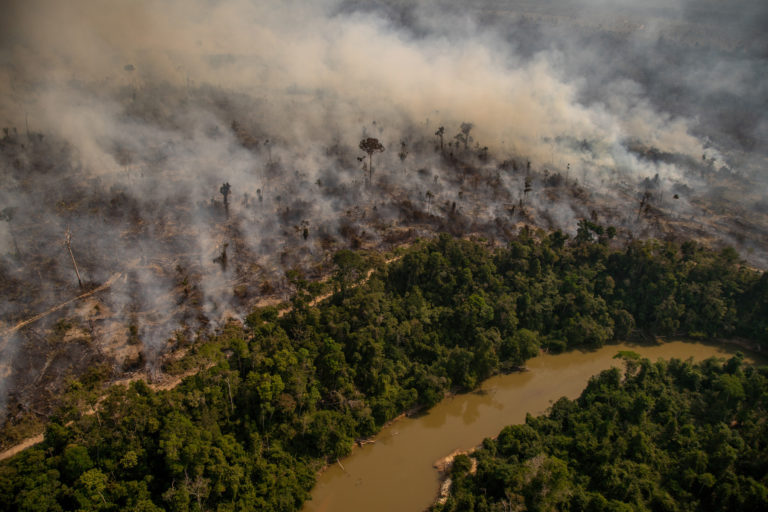
Against the backdrop of fires, rising forest loss, and increasingly dire warnings from scientists about the fate of the Amazon, journalists and NGOs continued to investigate and expose the actors driving deforestation in the region. The cattle, soy, and timber sectors were also subject to numerous reports and articles, which showed their culpability in driving the Amazon’s destruction as well as alleged illegal activity in some cases. The focus also widened in 2020 to look more at the banks, asset managers, and financial institutions that provide the funding to enable deforestation. A study published in the journal Science found that only about 2% of producers are responsible for the majority of illegal deforestation in the Amazon rainforest and Cerrado savanna.
Indonesia
2020 may come to be seen as a pivotal year for Indonesia’s forests. Deforestation in Indonesia has slowed since 2016, but the Indonesian government pressed forward on policies and projects that could become major drivers of deforestation for decades to come.
The year started off on a hopeful front from a forest conservation standpoint, building off a December 2019 decision by Indonesia’s Supreme Court to strike down a legal provision that effectively allowed plantation companies to operate illegally inside protected forests; the Indonesian government filing suit against plantation companies linked to peat fires in 2019; and President Joko Widodo, or “Jokowi,” calling for stronger action to address fires. In February, a state administrative court ruled that Indonesia’s agrarian ministry had to release detailed maps of oil palm plantations, including information about ownership, for concessions in the provinces of West Papua and Papua, which are viewed as the last frontier for large-scale deforestation in Indonesia. Such data is typically shielded from public view. Shortly thereafter, Luhut Pandjaitan, the coordinating minister for maritime affairs and investment, declared there would be no new permits approved for oil palm plantations in the region. That was followed by South Korea’s POSCO, which has been linked to large-scale deforestation in Papua for oil palm between 2012 and 2018, committing to a “no deforestation, no peatland, no exploitation” (NDPE) policy for its Papua operations.

At the same time as these developments however, there was a darker undercurrent in Indonesia: the creeping authoritarianism of the state, including rising militarization, weakening of oversight bodies like the anticorruption agency, crackdown on dissent, and targeting of civil society organizations and journalists. On this latter front, 2020 opened with Indonesia’s environment ministry terminating its forest conservation partnership with WWF (it later allowed WWF to continue working with endangered rhinos); Mongabay editor Phil Jacobson being detained in Central Kalimantan province; and environmental defenders in North Sumatra fearing for their lives for their efforts to protect the habitat of the Tapanuli orangutan from a hydropower project. The situation would worsen with the arrival of COVID-19.
Officially recorded COVID-19 cases in Indonesia grew gradually, but the government moved quickly on a sweeping deregulation bill that fast-tracked infrastructure and industrial agricultural projects. The “omnibus bill,” officially called the Job Creation Act, was contentious out of the gates, both due to conflict of interests — lawmakers who drafted the legislation had direct links to the companies that stood to benefit most from it — and the accelerated process by which it was deliberated and passed into law. Mining and plantation companies in particular gained from the weakening of environmental regulations, which environmentalists said would lead to increased deforestation and incidence of fire. The government arrested more than 6,000 people who protested the new law.
In parallel with the omnibus bill, the Indonesian government launched a push to expand a national “food estate” program by establishing millions of hectares of new plantations in Sumatra, Borneo, and Papua. The plans included reviving a failed mega rice project in a peat swamp in Indonesian Borneo, a scheme that in the 1990s caused an ecological, financial, and social disaster by unleashing large-scale deforestation and peat fires, undermining domestic food security, and exacerbating social unrest. President Jokowi appointed Prabowo Subianto, a former Special Forces commander who is now defense minister, to run the program, sparking fears that the military would be enlisted to advance agribusiness projects in a return to the approach under former dictator Suharto. In support of this objective, Indonesia’s environment ministry issued a new regulation allowing protected forest areas to be cleared for industrial plantations.

The new “food estate” regulations are expected to give a long-term boost to agribusiness giants in Indonesia, some of whom have been actively expanding in 2020. Digoel Agri Group, for example, has been clearing rainforest in what could become the world’s largest oil palm plantation. The Tanah Merah project could generate an estimated $6 billion in timber revenue alone from the forest that it threatens to clear. In its place would be a 280,000-hectare (692,000-acre) plantation, almost twice the size of London, in southern Papua on the Indonesia half of the island of New Guinea. Palm oil giant Korindo continued to find itself mired in controversy for unusual financial transactions, logging of forests, and illegal use of fire in its Papuan operation.
Indonesia advanced a plan to more the double its current oil palm estate to produce biodiesel. The scheme, which runs counter to its proclaimed ambition to become a global production hub for electric vehicles, would require establishing new oil palm plantations a fifth the size of Borneo. The biodiesel mandate would create a huge source of demand for palm oil that doesn’t need to meet international standards for avoiding deforestation or human rights abuses, countering corporate zero-deforestation policies and import restrictions imposed by the European Union. The energy ministry said it will have to meet the government’s sustainability standard, however.
Infrastructure remained a priority for the Jokowi administration. Work moved forward on major road projects in Papua and Sumatra despite social and environmental concerns. But the proposed move of the country’s capital to Borneo’s East Kalimantan province was postponed due the pandemic.
The Batang Toru dam was delayed by three years due to financing issues after major lenders pulled out of the project due to concerns the project is seismically unsound and could drive the critically endangered Tapanuli orangutan to extinction. But project developer PT North Sumatra Hydro Energy rejected calls for an independent environmental impact assessment of the project. The IUCN primate specialists’ section on great apes noted that “No robust studies have yet assessed” the impact of the project on the species.
Indonesia’s two main pulp and paper companies continued to flout their “zero deforestation” commitments, with APRIL linked to new deforestation in Borneo and Sumatra, and Asia Pulp & Paper (APP) sourcing fiber from a concession involved in peat forest destruction in Sumatra. The Forest Stewardship Council found itself under fire for what NGOs said was an inadequate effort to investigate reports of “alleged deforestation” by companies linked to Robert Budi Hartono, Indonesia’s wealthiest individual.

After initially planning to end its timber legality verification system (SVLK) for the export of timber products, Indonesia reversed itself and kept the program in place. The move would have blocked Indonesian wood products from some international markets, including the E.U.
A study published in Science Advances found that the Indonesia government’s poverty-alleviation program was as successful in reducing deforestation as dedicated conservation programs. Another study, published in PNAS, found that providing high-quality health care can be a strong incentive to avoid deforestation. The study concluded that deforestation in West Kalimantan’s Gunung Palung National Park fell 70% after a health clinic opened nearby.
A wetter than normal dry season meant that the fires and haze that have often affected Indonesia in recent years were less widespread in 2020, easing fears that air pollution could make COVID-19 especially deadly.
Congo Basin
Central Africa is experiencing the highest acceleration in deforestation of any major forest region on Earth. The forests of the Congo Basin face myriad threats: increased interest from industrial agriculture, proliferating road networks, new oil and gas exploration, and a regional drying trend. But foreign governments have also recently pledged more aid to Congo forest conservation.
The Democratic Republic of Congo (DRC) accounts for about 60% of the Congo Basin’s primary forest cover and nearly 80% of its loss. As such, it is seen by some as a bellwether for the region. In 2020 there were signs that forest disturbance may still be on an upward trend. In January, DRC granted nine forest concessions, covering more than 2 million hectares (5 million acres), to two Chinese companies, which environmental NGOs said violated a national moratorium on new concessions. NGOs have said COVID-19 has not slowed rampant illegal logging in the country.
DRC’s northern neighbor, the Republic of the Congo, has the third-largest extent of primary forest in the Congo Basin, but a much lower rate of loss. Accordingly, when the country last year announced a huge oil discovery in its enormous forested peatland, there were considerable concerns that oil extraction could become a major driver of degradation and carbon emissions. Responding to that worry, France and Germany offered up 60 million euros ($73 million) in aid to reduce the potential impact. However, a 2020 investigation by Der Spiegel and Mediapart suggest that the “alleged oil-field discovery was a bluff” or “an audacious exaggeration” to attract aid money from European governments. In other words, the deforestation threat from the supposed oil find remains low.
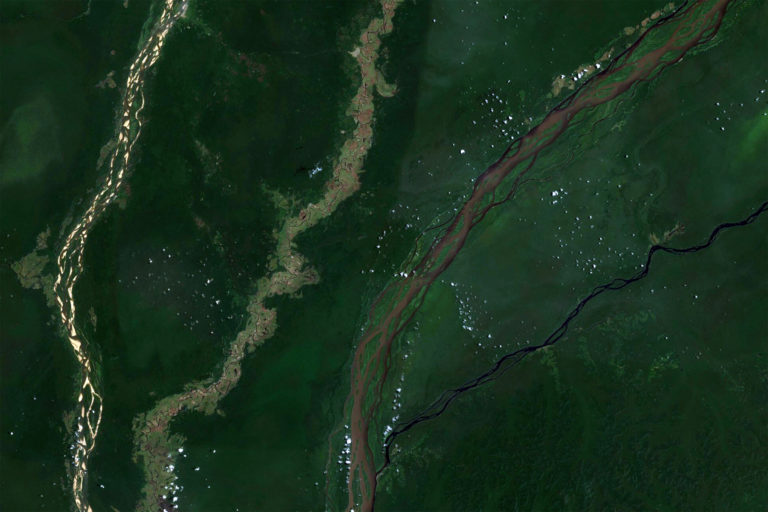
Gabon ranks just ahead of the Republic of the Congo in terms of forest cover in the Congo Basin. The country has historically had a very low deforestation rate, but loss has been rising as industrial agriculture expands in the country. In 2020 the biggest news on the deforestation front in Gabon was around an FSC investigation into whether Olam, a Singapore-based agribusiness company, deforested more than 25,000 hectares (62,000 acres).
Cameroon approved a 68,385-hectare (168,983-acre) logging concession in Ebo Forest, more than one-third of southwestern Cameroon’s largest intact forest. The area, which in the early 2010s was poised to be protected as a national park, is home chimpanzees, drills, and lowland gorillas. Meanwhile, an investigation by the Environmental Investigation Agency found evidence of illegal logging in the buffer zone of the Dja Fauna Reserve, a designated UNESCO World Heritage Site and a Biosphere Reserve.
Other regional developments
With deforestation trending upward in recent years, Peru cracked down on illegal gold mining, investigated large-scale deforestation linked to Mennonite communities, and took action against illegal logging. But new road projects, ongoing illegal logging and mining, and corporate efforts to undermine public prosecutors continued to post threats to Peruvian forests.
Read more: Peru news feed | Top stories in 2020 (Spanish)
More than 1.4 million hectares of Bolivia burned in 2020. Most of the forest fires occurred in the country’s dry Chaco forests. Protected areas were affected.
Colombia secured £64 million from the U.K. to protect forests, but still struggled to get a handle on rising deforestation. In January, Colombian President Iván Duque announced a goal to plant 180 million trees to restore some 300,000 hectares of degraded land, but National Nature Parks of Colombia has been forced to abandon 10 Amazonian parks that cover nearly 9 million hectares due to violence and threats from narcotraffickers, former FARC rebels, and other armed groups. These parks include Indigenous territories. Killings of environmental defenders and human rights advocates topped 300 people.
Read more: Colombia news feed | Top stories in 2020 (Spanish)
Sugarcane companies began clearing land within Bugoma Forest in Uganda after the environment authority approved an environmental impact assessment. The effort to clear Bugoma Forest for sugarcane has been a flashpoint since 2014.

Ongoing deforestation in Cambodia, including clearing of Keo Seima and Prey Lang wildlife sanctuaries continued to attract attention. A proposed reform of the country’s environment code remained stalled.
Deforestation for timber production and the establishment of plantations—including oil palm plantations—continued in Myanmar in 2020, despite regional crackdowns last year, including raids by Chinese authorities on stockpiles on China’s side of the border. Some of the illegally logged timber makes its way into E.U. markets despite the European Union Timber Regulation (EUTR), found an investigation by the Environmental Investigation Agency (EIA). On the conservation front, ethnic minorities in Myanmar raised concerns about lack of consultation on proposed conservation projects. Paul Sein Twa, a member of the Karen Indigenous group, won the Goldman Environmental Prize for his efforts to establish the 546,000-hectare Salween Peace Park, which encompasses 27 community forests and three wildlife sanctuaries.
Drivers of deforestation
2020 was a year when civil society focused more attention on “financed emissions,” the emissions released by companies in which financial institutions invest. In a tropical forest context, that means environmentalists targeted the banks, investment funds, asset managers, and other institutions that fund commodity production and infrastructure in tropical forests. Accordingly, a spate of reports were released in 2020, tying companies like Morgan Stanley, BlackRock, Citigroup, JPMorgan Chase, Goldman Sachs, and HSBC to deforestation in the Amazon and beyond.

From fires to deforestation, researchers continued to document the outsized impact cattle ranching in the Amazon, which accounts for more forest loss in the tropics than any other driver, has on planetary health. And activists continued to target Brazil’s biggest cattle producers and the actors who source from them, including a major beef supplier to the U.K. military and the fashion industry. Investigations showed that despite promises to clean up their supply chains, lack of transparency and accountability remains a problem for the Brazilian cattle industry.
“Forest risk” commodities like palm oil, timber and wood pulp production, and soy were also priorities for campaigners in 2020. Companies continued to establish and strengthen zero-deforestation commitments, sometimes in response to shareholder pressure. For example, Tyson Foods committed to a no-deforestation policy after activist investors led by Green Century Capital Management pressured the world’s second-biggest meat processor to do so. Two-thirds of Proctor & Gamble (P&G) shareholders voted to approve a resolution to address deforestation and forest degradation in the consumer product company’s supply chain. Ceres, a nonprofit that helps investors and companies adopt sustainability policies and practices, published an Investor Guide to Deforestation and Climate Change for institutional investors that covered the material risks of deforestation, forest risk commodities and countries, and how to evaluate corporate forest policies.
Palm oil
After dipping sharply in March and April due to the spread of COVID-19, the price of palm oil surged, reaching the highest level in more than six years by the end of 2020. Growers may see the rising price, coupled with relaxed regulations and a massive buying program from the Indonesian government in the form of a biodiesel mandate, as a signal to ramp up expansion.

Concerns over the environmental impact of converting rainforests and peatlands to oil palm plantations has spawned the rise of the corporate “no deforestation, no peat, no exploitation” (NDPE) policy over the past decade. Hundreds of companies across the palm oil supply chain, from producers to traders to food and cosmetics manufacturers, have established such policies and pledged to significantly reduce or eliminate deforestation for palm oil production in their supply chains by the end of 2020. Yet the Zoological Society of London’s (ZSL) annual assessment of 100 of the world’s largest palm oil players suggests that many companies will fail to meet these commitments by their self-imposed deadlines.
The most conspicuous palm oil company, Wilmar, unsurprisingly continued to be a focal point for advocacy groups trying to effect change in the palm oil sector. Notably, Wilmar attracted criticism when it exited the the steering group of the High Carbon Stock Approach (HCSA), which helps set the rules that underpin NDPE policies. That decision was immediately relevant to a case in Papua, where a Wilmar supplier was found to be clearing primary rainforest for oil palm.
PepsiCo, another long-time target of environmental groups, updated its NDPE policy for palm oil to extend to all subsidiaries and third-party suppliers. The move was notable because PepsiCo’s Indonesian joint-venture partner, Indofood, has been found in breach of such policies by the Roundtable on Sustainable Palm Oil (RSPO), the dominant certification body for the palm oil sector.
A comprehensive study based on socioeconomic data found that oil palm development has had mixed impacts on local peoples’ livelihoods in Indonesia. Communities that are more dependent on forests tend to fare worse when oil palm expansion occurs, whether or not those plantations are certified by the RSPO.
Read more: Top Indonesian palm oil developments in 2020
Amazon soy
A number of studies looked at the environmental footprint of soy from the Amazon rainforest and the Cerrado, a neighboring woody savanna. One study, published in the journal Global Environmental Change, estimated that China accounted for 51% of carbon dioxide emissions associated with Brazil soy exports, while the European Union is responsible for about 30%. That study also found that EU imports were also more likely to cause new deforestation compared to imports from China. These concerns contributed to France’s announcement on Dec. 1 that it would eventually eliminate soy imports from Brazil.

While research and NGO reports found the impact of soy on the Amazon and Cerrado to be significant, another study argued the impact of soy production in Brazil would have been far worse had a group of companies not signed the Amazon soy moratorium in 2006. That research, published in the journal Nature Food, concludes that deforestation in the Brazilian Amazon between 2006 and 2016 was 35% lower than it would have been without the moratorium, avoiding deforestation of some 18,000 square kilometers (7,000 square miles) of Amazon forest. The moratorium, which was established after a Greenpeace campaign, eventually became the blueprint for zero-deforestation policies that came to be applied to other tropical commodities like palm oil, rubber, cacao, and wood pulp.
Technology
By restricting access to the field, the pandemic amplified the importance of remote-sensing technologies at a time when advances in monitoring tropical forests were already accelerating. One of the biggest news stories is this space was the Norwegian government’s decision to pay three satellite monitoring technology groups — Kongsberg Satellite Services, Planet, and Airbus — to provide free access to high-resolution satellite imagery of the tropics, which will help researchers, governments, and civil society improve forest monitoring, emissions tracking, and the use of AI to anticipate land use change.
After last year’s headline-grabbing fire season in the Amazon, researchers applied new tools and methodologies to fire mapping in the region. For example, NASA rolled out an automated near-real-time fire monitoring system that differentiates between land use history and fire type. The Amazon Conservation Association’s MAAP Initiative deployed its own fire tracking effort, which was the first to publicly distinguish agricultural fires and forest fires at scale in the Amazon.
But just like how the pandemic amplified the digital divide between the haves and have nots across society as a whole, human rights advocates warned that the same issue is affecting the digitization of land registries. A report from human rights group GRAIN said that communities that lack familiarity with technological tools are finding themselves at a disadvantage as governments move toward digital land registries.
The boom in renewable energy also brought greater scrutiny to the impact of production of the metals and other materials that go into battery technologies. Elon Musk raised eyebrows when he tweeted “We will coup whoever we want! Deal with it,” in response to the ouster of the president of lithium-rich Bolivia — suggesting that the Telsa CEO would back coups that benefit his companies. After sharp criticism, Musk deleted the Tweet and said Tesla gets its lithium from Australia.
Action by consuming countries
Rich-world governments continued to consider how their population’s consumption of commodities drives deforestation in the tropics. The U.K. put forth a new law that would make it illegal to for large companies operating in the country to use products grown on land that was illegally deforested. That law, if passed, would effectively require big companies to carry out due diligence on their supply chains.
In October, the governments of Switzerland and Peru reached a carbon offsetting deal under Article 6 of the Paris climate agreement. Switzerland will get carbon credits generated by financing sustainable development projects that reduce greenhouse gas emissions in the South American nation. That deal could become a model for other bilateral agreements.

The French government, which pledged in 2019 to stop “deforestation imports” by 2030, continued to move forward on its National Strategy to Combat Imported Deforestation, announcing it aimed to stop importing soy from Brazil.
Norway increased the rate it pays tropical countries to protect rainforests and made its first payment to Indonesia under a REDD+ agreement signed in 2010.
China’s revision to its forest law, which bars companies from buying or processing illegal timber, came into effect July 1, 2020. On paper, the law could be a “game changer” for the world’s largest importer of tropical timber, according to the Environmental Investigation Agency (EIA), but it is unclear how it will be interpreted and enforced.
Forest research
While there was plenty of important tropical forest research published in 2020, here is a small set of noteworthy studies that didn’t fit into the sections above.
Only 47% of the world’s tropical rainforests have high “ecological integrity”, meaning they have tall, closed canopies and limited human activity. Less than 7% of these forests are legally protected. (Nature Ecology and Evolution)
Between 1992 and 2014 forest degradation outpaced deforestation in the Brazilian Amazon. During that period, 308,311 square kilometers were cleared outright, while 337,427 square kilometers were merely degraded, primarily by logging and fires. (Science)
Warmer temperatures shorten the lifespans of tropical trees, especially when mean annual temperatures exceed 25.4° Celsius. With climate change expected to increase temperatures significantly across the tropics, the capacity of rainforests to sequester carbon may be diminished. (Proceedings of the National Academy of Sciences)
Only 47% of the world’s tropical rainforests have high “ecological integrity”, meaning they have tall, closed canopies and limited human activity. Less than 7% of these forests are legally protected. (Nature Ecology and Evolution)
Long-lived pioneer trees account for a disproportionate amount of carbon stored in tropical forests, making them especially important in sequestering atmospheric carbon dioxide. (Science)
Defaunation of large-bodied animals in tropical forests is degrading the capacity of such forests to store carbon and afford other important ecosystem services. (Nature Communications)

China, Brazil, and Indonesia have the greatest potential for sequestering carbon via reforestation projects. Russia, the U.S., India, and the Democratic Republic of Congo are other strong candidates. (Nature)
Less than 10% of the world’s protected areas are connected by land that’s considered intact, making it difficult for some species to move from one refuge to another and hurting the ability of these ecological “islands” to adapt to environmental change. (Nature Communications)
Planned road projects in the Amazon could unleash 2.4 million hectares of deforestation in the next 20 years. (Proceedings of the National Academy of Sciences)
12 REDD+ (Reduced Emissions from Deforestation and forest Degradation) projects in the Brazilian Amazon have tended to overstate their climate benefits, concluded a study which looked at 12 voluntary projects. The research found the exaggerated emissions savings tended to result from deforestation baselines that failed to account for broader reductions in deforestation that occurred independently. (Proceedings of the National Academy of Sciences)
Deforestation typically accelerates once 50% of an area’s forest is loss, suggesting the halfway point represents a critical tipping point or threshold. (Geophysical Research Letters)
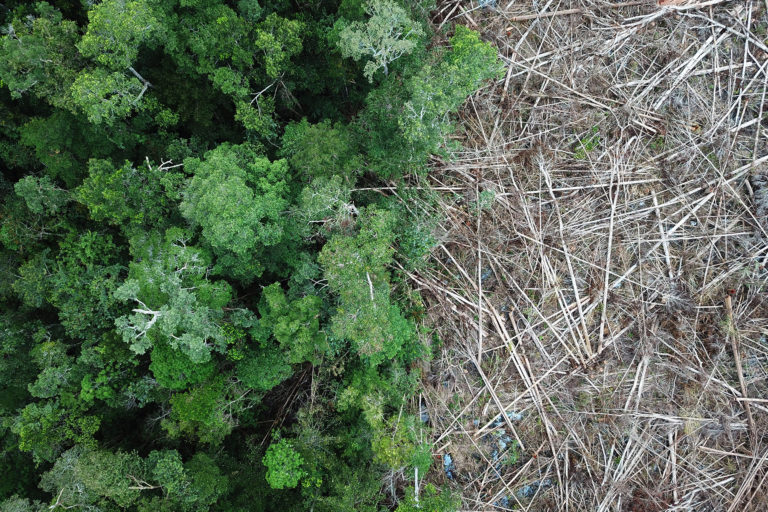
Humans have contributed to 56% decline in species in mammal assemblages across the American tropics since European colonization began around 1500. (Nature Scientific Reports)
Climate change may be driving a sharp decline in fruit production in Gabon, making life more challenging for resident megafauna. (Science)
What’s in store for 2021?
Next week, Mongabay will took at look at some of the tropical forest trends and potential developments to watch in 2021.
Related posts:
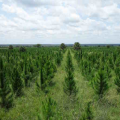
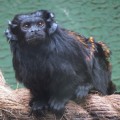 Oil palm plantations in Amazonia inhospitable to tropical forest biodiversity: Study
Oil palm plantations in Amazonia inhospitable to tropical forest biodiversity: Study
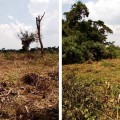 ‘A shame for the world’: Uganda’s fragile forest ecosystem destroyed for sugar
‘A shame for the world’: Uganda’s fragile forest ecosystem destroyed for sugar
 About 41 million people food insecure in E. Africa amid COVID-19 pandemic: UN
About 41 million people food insecure in E. Africa amid COVID-19 pandemic: UN
 Bugoma forest under threat again as more 2000Ha is dished to investors
Bugoma forest under threat again as more 2000Ha is dished to investors
You may like
SPECIAL REPORTS AND PROJECTS
‘Left to suffer’: Kenyan villagers take on Bamburi Cement over assaults, dog attacks
Published
3 months agoon
March 22, 2025
- The victims are aged between 24 and 60, and one of them has since passed on.
- Many were severely injured and hospitalized following brutal attacks, unlawful detention, and physical assault by Bamburi’s security personnel.
Editor’s note: Read the petition here.
Their hopes for justice seemed to be slipping away after initially taking on a multinational corporation and failing to hold it accountable for the brutal injuries they suffered.
The death of one of their own cast a shadow of despair, making it seem unlikely that they would ever bring the corporation to justice for the crimes they alleged.
However, 11 victims of dog attacks, assaults, and other severe human rights violations are now challenging Bamburi Cement PLC’s role in these abuses in court.
They are represented by the Kenya Human Rights Commission (KHRC), which on January 29, 2025, filed a legal claim before a constitutional court in Kenya, seeking to hold the multinational accountable for the harm suffered by the victims—residents of land parcels in Kwale that Bamburi claims ownership of. KHRC worked with the Kwale Mining Alliance (KMA) to bring this case.
The victims, aged between 24 and 60, include Mohamed Salim Mwakongoa, Ali Said, Abdalla Suleiman, Hamadi Jumadari, Abdalla Mohammed, and Omari Mbwana Bahakanda. Others are Shee Said Mbimbi, Omar Mohamed, Omar Ali Kalendi (deceased), Abdalla Jumadari, and Bakari Nuri Kassim.
Bamburi had hired a private security firm and deployed General Service Unit (GSU) officers to guard three adjoining land parcels, covering approximately 1,400 acres in Denyenye, Kwale. The GSU established a camp on the land, which has historically been accessed by residents who have long used established routes to reach the forest and the Indian Ocean.
For decades, these routes provided them with access to resources such as firewood, crops, and fish, which they relied on for their livelihoods. However, five years ago, when they attempted to collect firewood, harvest crops, and access the ocean through the land, Bamburi accused them of trespassing. The company’s private guards and GSU officers responded with force, setting dogs on them and assaulting them.
Many were severely injured and hospitalized following brutal attacks, unlawful detention, and physical assault by Bamburi’s security personnel. These incidents occurred despite the lack of clearly defined boundaries and the fact that the traditional access routes had never been contested.
According to the petition, GSU officers and private guards inflicted serious injuries by kicking, punching, and beating the victims with batons. Those who were arrested were neither taken to a police station nor charged with any offense. Despite their injuries, they were denied emergency medical care.
These actions were intended to intimidate residents, prevent them from accessing the beach, and suppress any historical claims to the land, the victims tell the court. Local police in Kwale failed to investigate the abuses, visit the crime scenes, or arrest any of the perpetrators, they add.
Now, the victims are seeking compensation for these violations. They have also asked the court to declare that their rights were violated through torture inflicted by Bamburi’s guards and GSU officers. Additionally, they want the court to rule that releasing guard dogs to attack them during arrests constituted an extreme and unlawful use of force.
Source: khrc.or.ke
Related posts:
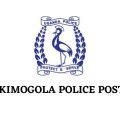
 Breaking: Over 600 attacks against defenders have been recorded in the year 2023 globally- BHRRC report.
Breaking: Over 600 attacks against defenders have been recorded in the year 2023 globally- BHRRC report.
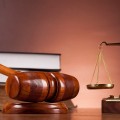 Kaweeri Coffee land grabbing case re-trial resumes as evictees continue to suffer gross human rights violations.
Kaweeri Coffee land grabbing case re-trial resumes as evictees continue to suffer gross human rights violations.
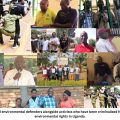 Criminalization of planet, land, and environmental defenders in Uganda is on the increase as 2023 recorded the soaring number of attacks.
Criminalization of planet, land, and environmental defenders in Uganda is on the increase as 2023 recorded the soaring number of attacks.
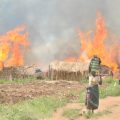 Local land grabbers evict villagers at night; foreign investors cultivate the same lands the next day
Local land grabbers evict villagers at night; foreign investors cultivate the same lands the next day
SPECIAL REPORTS AND PROJECTS
River ‘dies’ after massive acidic waste spill at Chinese-owned copper mine
Published
3 months agoon
March 22, 2025A catastrophic acid spill from a Chinese-owned copper mine in Zambia has contaminated a major river, sparking fears of long-term environmental damage and potential harm to millions of people.
The spill, which occurred on February 18, has sent shockwaves through the southern African nation.
Investigators from the Engineering Institution of Zambia revealed that the incident stemmed from the collapse of a tailings dam at the mine.
This dam, designed to contain acidic waste, released an estimated 50 million litres of toxic material into a stream feeding the Kafue River, Zambia’s most important waterway.
The waste is a dangerous cocktail of concentrated acid, dissolved solids, and heavy metals.
The Kafue River, stretching over 930 miles (1,500 kilometres) through the heart of Zambia, supports a vast ecosystem and provides water for millions. The contamination has already been detected at least 60 miles downstream from the spill site, raising serious concerns about the long-term impact on both human populations and wildlife.
Environmental activist Chilekwa Mumba, working in Zambia’s Copperbelt Province, described the incident as “an environmental disaster really of catastrophic consequences”.
The spill underscores the risks associated with mining, particularly in a region where China holds significant influence over the copper industry.
Zambia ranks among the world’s top 10 copper producers, a metal crucial for manufacturing smartphones and other technologies.
Zambian President Hakainde Hichilema has appealed for expert assistance to address the crisis. The full extent of the environmental damage is still being assessed.
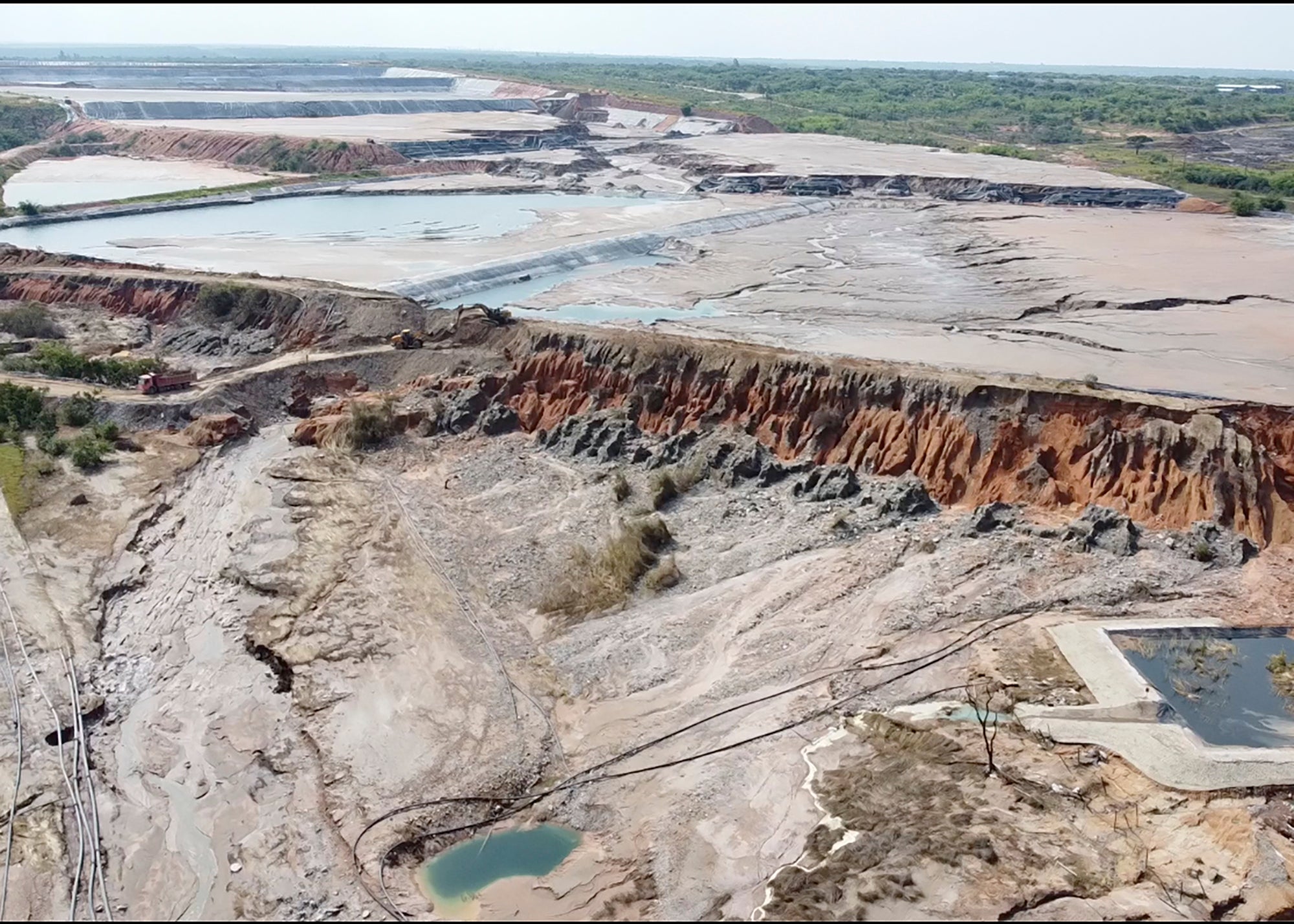
A river died overnight
An Associated Press reporter visited parts of the Kafue River, where dead fish could be seen washing up on the banks about 60 miles downstream from the mine run by Sino-Metals Leach Zambia, which is majority owned by the state-run China Nonferrous Metals Industry Group.
The Ministry of Water Development and Sanitation said the “devastating consequences” also included the destruction of crops along the river’s banks. Authorities are concerned that ground water will be contaminated as the mining waste seeps into the earth or is carried to other areas.
“Prior to February 18 this was a vibrant and alive river,” said Sean Cornelius, who lives near the Kafue and said fish died and birdlife near him disappeared almost immediately.
“Now everything is dead, it’s like a totally dead river. Unbelievable. Overnight, this river died.”
About 60 per cent of Zambia’s 20 million people live in the Kafue River basin and depend on it in some way as a source of fishing, irrigation for agriculture and water for industry. The river supplies drinking water to about five million people, including in the capital, Lusaka.
The acid leak at the mine caused a complete shutdown of the water supply to the nearby city of Kitwe, home to an estimated 700,000 people.
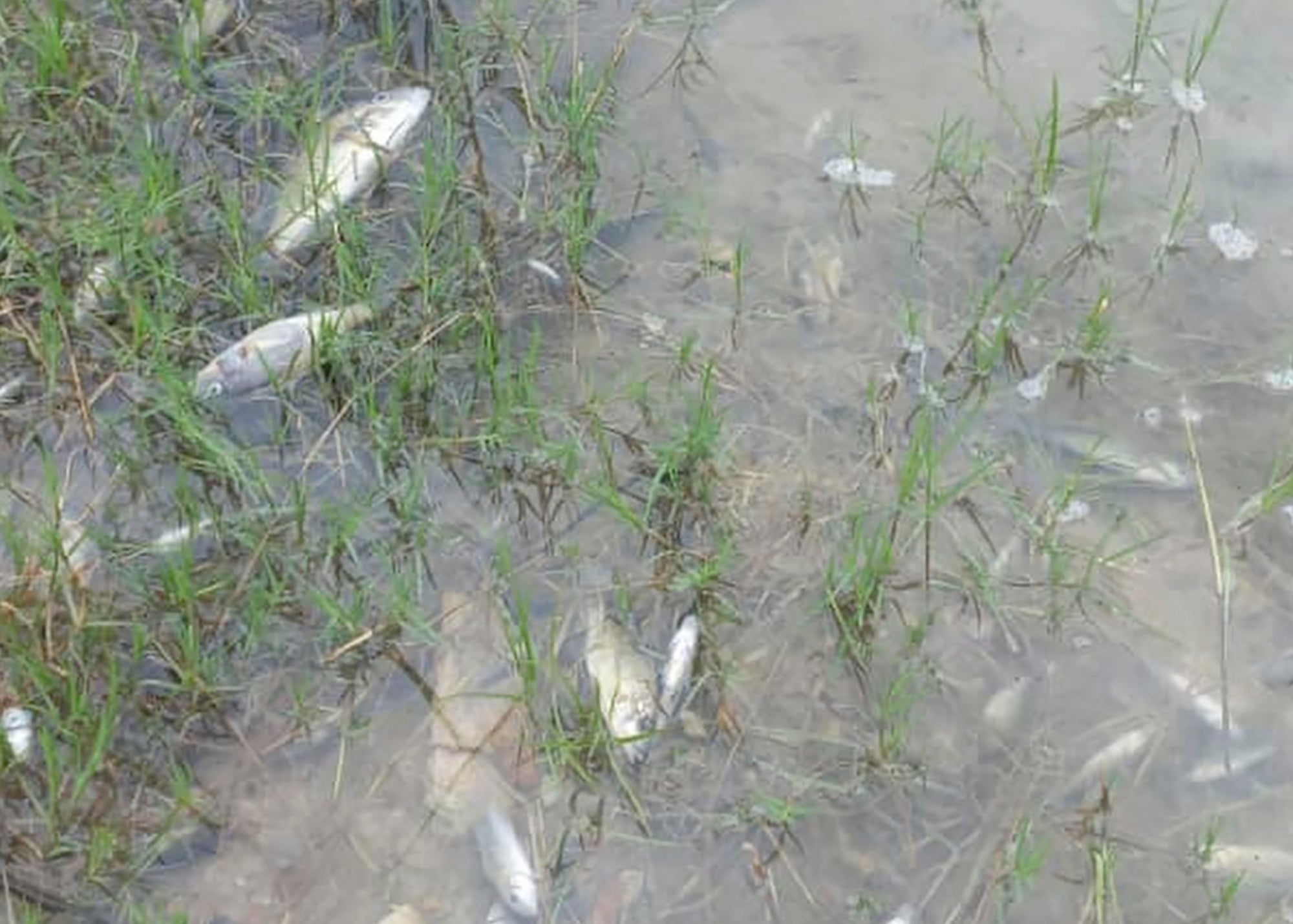
Attempts to roll back the damage
The Zambian government has deployed the air force to drop hundreds of tons of lime into the river in an attempt to counteract the acid and roll back the damage. Speed boats have also been used to ride up and down the river, applying lime.
Government spokesperson Cornelius Mweetwa said the situation was very serious and Sino-Metals Leach Zambia would bear the costs of the cleanup operation.
Zhang Peiwen, the chairman of Sino-Metals Leach Zambia, met with government ministers this week and apologized for the acid spill, according to a transcript of his speech at the meeting released by his company.
“This disaster has rung a big alarm for Sino-Metals Leach and the mining industry,” he said.
It “will go all out to restore the affected environment as quickly as possible”, he said.

Discontent with Chinese presence
The environmental impact of China’s large mining interests in mineral-rich parts of Africa, which include Zambia’s neighbors Congo and Zimbabwe, has often been criticised, even as the minerals are crucial to the countries’ economies.
Chinese-owned copper mines have been accused of ignoring safety, labour and other regulations in Zambia as they strive to control its supply of the critical mineral, leading to some discontent with their presence.
Zambia is also burdened with more than $4 billion in debt to China and had to restructure some of its loans from China and other nations after defaulting on repayments in 2020.
A smaller acid waste leak from another Chinese-owned mine in Zambia’s copper belt was discovered days after the Sino-Metals accident, and authorities have accused the smaller mine of attempting to hide it.
Local police said a mine worker died at that second mine after falling into acid and alleged that the mine continued to operate after being instructed to stop its operations by authorities. Two Chinese mine managers have been arrested, police said.
Both mines have now halted their operations after orders from Zambian authorities, while many Zambians are angry.
“It really just brings out the negligence that some investors actually have when it comes to environmental protection,” said Mweene Himwinga, an environmental engineer who attended the meeting involving Mr Zhang, government ministers, and others.
“They don’t seem to have any concern at all, any regard at all. And I think it’s really worrying because at the end of the day, we as Zambian people, (it’s) the only land we have.”
Source: www.independent.co.uk
SPECIAL REPORTS AND PROJECTS
How Carbon Markets are Exploiting Marginalised Communities in the Global South Instead of Uplifting them
Published
7 months agoon
December 11, 2024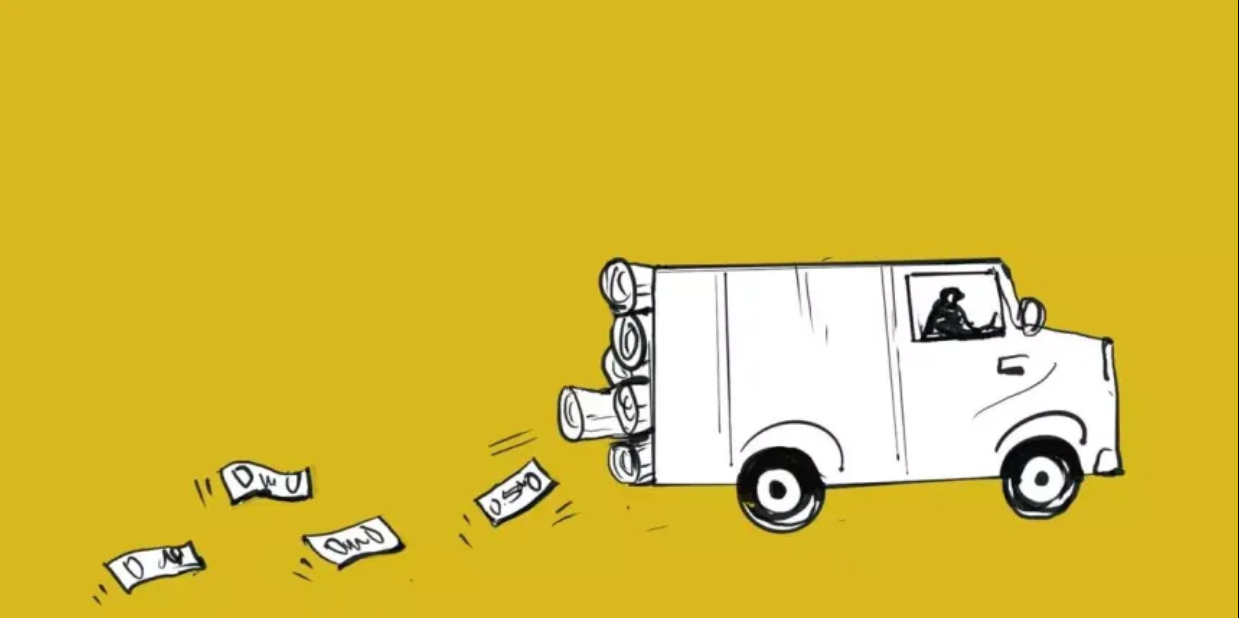
The billion-dollar fiction of carbon offsets
Carbon markets are turning indigenous farming practices into corporate profit, leaving communities empty-handed.
For Janni Mithula, 42, a resident of the Thotavalasa village in Andhra Pradesh, cultivating the rich, red soil of the valley was her livelihood. On her small patch of land grow with coffee and mango trees, planted over decades with tireless care and ancestral knowledge. Yet, once a source of pride and sustainability, the meaning of these trees has been quietly redefined in ways she never agreed to.
Over a decade ago, more than 333 villages in the valley began receiving free saplings from the Naandi Foundation as part of a large-scale afforestation initiative funded by a French entity, Livelihoods Funds. Unbeknownst to Janni and her neighbours, these trees had transfigured into commodities in a global carbon market, their branches reaching far beyond the valley to corporate boardrooms, their roots tethered not to the soil of sustenance but to the ledger of profit and carbon offsets.
The project claims that it would offset nearly 1.6 million tonnes of carbon dioxide equivalent over two decades. On paper, it is a triumph for global climate efforts. In reality, the residents’ lives have seen little improvement. While the sale of carbon credits has reportedly fetched millions of dollars for developers, Janni’s rewards have been minimal: a few saplings, occasional training sessions, and the obligation to care for trees that she no longer fully owns. These invisible transactions pose a grave risk to marginalised communities, who practice sustainable agriculture out of necessity rather than trend.
Also Read | COP29: The $300 billion climate finance deal is an optical illusion
The very systems that could uplift them—carbon markets intended to fund sustainability—end up exploiting their resources without addressing their needs.
Earlier this year, the Centre for Science and Environment (CSE) and Down To Earth (DTE) released a joint investigative report on the functioning of the voluntary carbon market in India. The report critically analysed the impacts of the new-age climate solution, its efficacy in reducing carbon emissions, and how it affected the communities involved in the schemes.
The findings highlighted systemic opacity, with key details about the projects, prices, and beneficiaries concealed under confidentiality clauses. Developers also tended to overestimate their emission reductions while failing to provide local communities with meaningful compensation. The report stated that the main beneficiaries of these projects were the project developers, auditors and companies that make a profit out of the carbon trading system.
Carbon markets: The evolution
On December 11, 1997, the parties to the United Nations Framework Convention on Climate Change (UNFCC) convened and adopted the Kyoto Protocol with the exigence of the climate crisis bearing down on the world. The Kyoto Protocol, revered for its epochal impact on global climate policy, focused on controlling the emissions of prime anthropogenic greenhouse gases (GHGs). One of the key mechanisms introduced was the “Clean Development Mechanism”, which would allow developed countries to invest in emission reduction projects in developing countries. In exchange, the developed countries would receive certified emission reduction (CER) credits, or carbon credits as they are commonly known.
One carbon credit represents the reduction or removal of one tonne of CO2. Governments create and enforce rules for carbon markets by setting emission caps and monitoring compliance with the help of third-party organisations. For example, the European Union Emissions Trading System (EU-ETS) sets an overall cap on emissions and allocates allowances to industries. A financial penalty system was also put in place to prevent verifiers and consultants from falsifying emissions data. The impact of these renewable projects is usually verified through methods such as satellite imagery or on-site audits.
Companies such as Verra and Gold Standard have seized this opportunity, leading the designing and monitoring of carbon removal projects. Governments and corporations invest in these projects to meet their own net-zero pledges. The companies then issue carbon credits to the investing entity. Verra has stated that they have issued over 1 billion carbon credits, translating into the reduction of 1 billion tonnes of greenhouse gas emissions. However, countless case studies and reports have indicated that only a small fraction of these funds reach the local communities practising sustainability.
Article 6 under the Paris Agreement further concretised and regulated the crediting mechanism to enable countries interested in setting up carbon trading schemes. However, the parties failed to reach a consensus regarding the specifics of Article 6 at COP 27 and COP 28. So, climate finance experts and policymakers were very interested in the developments taking place at the COP 29 summit in Baku, Azerbaijan. Unlike its predecessors, the COP 29 summit has seen a diminished attendee list, with major Western political leaders including Joe Biden, Ursula von der Leyen, Olaf Scholz, and Emmanuel Macron failing to make it to the summit due to the increasingly turbulent climate within their own constituencies.
From a post-colonial perspective, carbon markets have been viewed as perpetuating existing global hierarchies; wealthier countries and corporations fail to reduce their emissions and instead shift the burden of mitigation onto developing nations. | Photo Credit: Illustration by Irfan Khan
Sceptics questioned whether this iteration of the summit would lead to any substantial decisions being passed. However, on day-two of the summit, parties reached a landmark consensus on the standards for Article 6.4 and a dynamic mechanism to update them. Mukhtar Babayev, the Minister of Ecology and Natural Resources of Azerbaijan and the COP 29 President, said: “By matching buyers and sellers efficiently, such markets could reduce the cost of implementing Nationally Determined Contributions by 250 billion dollars a year.” He added that cross-border cooperation and compromise would be vital in fighting climate change.
India has positioned itself as an advocate for the Like-Minded Developing Countries (LMDCs) group, with Naresh Pal Gangwar, India’s lead negotiator at COP 29, saying, “We are at a crucial juncture in our fight against climate change. What we decide here will enable all of us, particularly those in the Global South, to not only take ambitious mitigation action but also adapt to climate change.”
The COP 29 decision comes in light of the Indian government’s adoption of the amended Energy Conservation Act of 2022, which enabled India to set up its own carbon market. In July 2024, the Bureau of Energy Efficiency (BEE), an agency under the Ministry of Power, released a detailed report containing the rules and regulations of the Carbon Credit Trading Scheme (CCTS), India’s ambitious plan for a compliance-based carbon market. The BEE has aimed to launch India’s carbon market in 2026.
CSE’s report highlighted the challenges and possible strategies that the Indian carbon market could adopt from other carbon markets around the world. Referring to this report, Parth Kumar, a programme manager at CSE, pointed out how low carbon prices and low market liquidity would be prominent challenges that the nascent Indian market would have to tackle.
The Global South should be concerned
Following the landmark Article 6.4 decision, climate activists called out the supervisory board for the lack of discussion in the decision-making process. “Kicking off COP29 with a backdoor deal on Article 6.4 sets a poor precedent for transparency and proper governance,” said Isa Mulder, a climate finance expert at Carbon Market Watch. The hastily passed decision reflects the pressure that host countries seem to face; a monumental decision must be passed for a COP summit to be touted as a success.
The science behind carbon markets is rooted in the ability of forests, soil, and oceans to act as carbon sinks by capturing atmospheric carbon dioxide. This process is known as carbon sequestration, and it is central to afforestation and soil health restoration projects. However, the long-term efficacy and scalability of these projects have been repeatedly questioned. The normative understanding of carbon markets as a tool to mitigate climate change has also come under scrutiny recently, with many activists calling the market-driven approach disingenuous to the goals of the climate movement.
From a post-colonial perspective, carbon markets have been viewed as perpetuating existing global hierarchies; wealthier countries and corporations fail to reduce their emissions and instead shift the burden of mitigation onto developing nations. Olúfẹ́mi O. Táíwò, Professor of Philosophy at Georgetown University, said, “Climate colonialism is the deepening or expansion of foreign domination through climate initiatives that exploit poorer nations’ resources or otherwise compromises their sovereignty.” Moreover, the effects of climate change disproportionately fall on the shoulders of marginalised communities in the Global South, even though industrialised nations historically produce the bulk of emissions.
There have also been doubts surrounding the claiming process of carbon credits and whether the buyer country or the country where the project is set can count the project towards its own Nationally Determined Contributions (NDCs). Provisions under Article 6 of the Paris Agreement state that countries cannot use any emission reductions sold to another company or country towards their own emissions targets. However, this has become a widespread issue plaguing carbon markets. The EU has recently been criticised for counting carbon credits sold to corporations under the Carbon Removal Certification Framework (CRCF) towards the EU’s own NDC targets. This has led to concerns over the overestimation of the impact of mission reduction projects.
Also Read | India needs climate justice, not just targets
Carbon offset projects, additionally, alienate local communities from their land as the idea of ownership and stewardship becomes muddled with corporate plans on optimally utilising the land for these projects. For example, in 2014, Green Resources, a Norwegian company, leased more than 10,000 hectares of land in Uganda, with additional land being leased in Mozambique and Tanzania. This land was used as a part of afforestation projects to practise sustainability and alleviate poverty in the area. However, interviews conducted with local Ugandan villagers revealed that the project forcibly evicted the local population without delivering its promises to improve access to health and education for the community. These concerns highlighted how the burden of adopting sustainable practices is placed on marginalised communities.
While carbon markets are rightfully criticised, they remain a key piece of the global climate adaptation puzzle. Addressing the issues surrounding transparency and equitable benefit-sharing with local communities could lead to carbon markets having a positive impact on climate change. The system must ensure that larger corporations and countries do not merely export their emissions, but instead implement measures to reduce their own emissions over time. It is also imperative to explore other innovative strategies such as circular economy approaches and nature-based solutions that are more localised, offering hope for a just and sustainable future.
Adithya Santhosh Kumar is currently pursuing a Master’s in Engineering and Policy Analysis at the Delft University of Technology in the Netherlands.
Source: frontline.thehindu.com
Related posts:
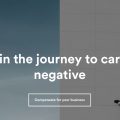
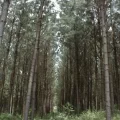 A new destructive business: Carbon credits from tree plantations
A new destructive business: Carbon credits from tree plantations
 East Africa poised to monitor carbon emission
East Africa poised to monitor carbon emission
 The Rush for Carbon Concessions: More Land Theft and Deforestation
The Rush for Carbon Concessions: More Land Theft and Deforestation
 Uganda: Local communities claim they are not benefiting from Green Resources’ subsidiary’s carbon credit initiative; incl. company’s comments
Uganda: Local communities claim they are not benefiting from Green Resources’ subsidiary’s carbon credit initiative; incl. company’s comments

Communities Under Siege: New Report Reveals World Bank Failures in Safeguard Compliance and Human Rights Oversight in Tanzania

A decade of displacement: How Uganda’s Oil refinery victims are dying before realizing justice as EACOP secures financial backing to further significant environmental harm.

Carbon Markets Are Not the Solution: The Failed Relaunch of Emission Trading and the Clean Development Mechanism

Govt launches Central Account for Busuulu to protect tenants from evictions

Uganda’s top Lands Ministry official has been arrested and charged with Corruption and Abuse of Office, a significant event that will have far-reaching implications for land governance in the country.

A decade of displacement: How Uganda’s Oil refinery victims are dying before realizing justice as EACOP secures financial backing to further significant environmental harm.

Govt launches Central Account for Busuulu to protect tenants from evictions

Environmentalists raise red flags over plan to expand oil palm fields in Kalangala

Innovative Finance from Canada projects positive impact on local communities.
Over 5000 Indigenous Communities evicted in Kiryandongo District
Petition To Land Inquiry Commission Over Human Rights In Kiryandongo District
Invisible victims of Uganda Land Grabs
Resource Center
- LAND GRABS AT GUNPOINT REPORT IN KIRYANDONGO DISTRICT
- RESEARCH BRIEF -TOURISM POTENTIAL OF GREATER MASAKA -MARCH 2025
- The Mouila Declaration of the Informal Alliance against the Expansion of Industrial Monocultures
- FORCED LAND EVICTIONS IN UGANDA TRENDS RIGHTS OF DEFENDERS IMPACT AND CALL FOR ACTION
- 12 KEY DEMANDS FROM CSOS TO WORLD LEADERS AT THE OPENING OF COP16 IN SAUDI ARABIA
- PRESENDIANTIAL DIRECTIVE BANNING ALL LAND EVICTIONS IN UGANDA
- FROM LAND GRABBERS TO CARBON COWBOYS A NEW SCRAMBLE FOR COMMUNITY LANDS TAKES OFF
- African Faith Leaders Demand Reparations From The Gates Foundation.
Legal Framework
READ BY CATEGORY
Newsletter
Trending
-

 MEDIA FOR CHANGE NETWORK1 week ago
MEDIA FOR CHANGE NETWORK1 week agoA decade of displacement: How Uganda’s Oil refinery victims are dying before realizing justice as EACOP secures financial backing to further significant environmental harm.
-

 MEDIA FOR CHANGE NETWORK2 weeks ago
MEDIA FOR CHANGE NETWORK2 weeks agoGovt launches Central Account for Busuulu to protect tenants from evictions
-

 WITNESS RADIO MILESTONES2 weeks ago
WITNESS RADIO MILESTONES2 weeks agoTop 10 agribusiness giants: corporate concentration in food & farming in 2025
-

 MEDIA FOR CHANGE NETWORK2 weeks ago
MEDIA FOR CHANGE NETWORK2 weeks agoCarbon Markets Are Not the Solution: The Failed Relaunch of Emission Trading and the Clean Development Mechanism
-

 NGO WORK21 hours ago
NGO WORK21 hours agoCommunities Under Siege: New Report Reveals World Bank Failures in Safeguard Compliance and Human Rights Oversight in Tanzania







